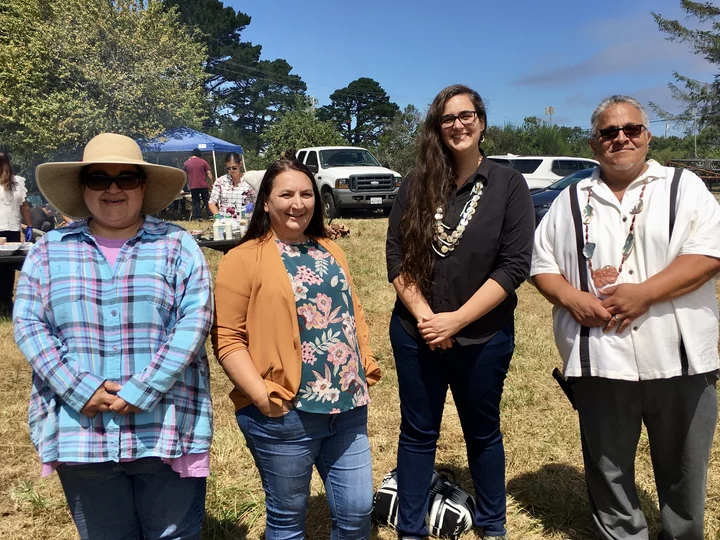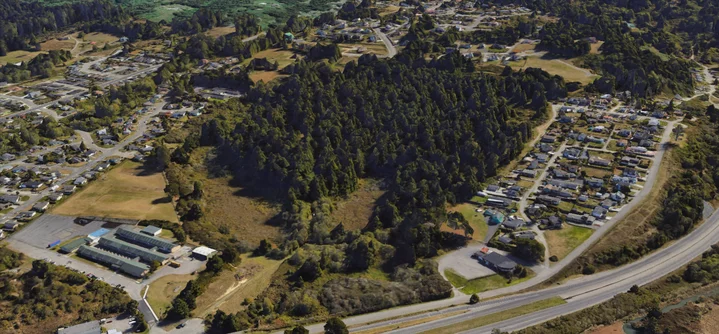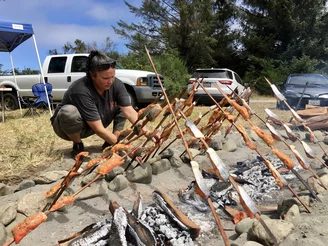From left: Marnie Atkins, Wiyot Cultural Center manager; Michelle Vassel, Wiyot Tribal administrator; Geneva EB Thompson, assistant secretary for tribal affairs at the California Natural Resources Agency; and Ted Hernandez, cultural director for the Wiyot Tribe at the Mouralherwaqh celebration Friday | Photos: Stephanie McGeary
###
Members of the Wiyot Tribe and other community members gathered near King Salmon on Friday afternoon to celebrate the transfer of a 46-acre piece of land to the Wiyot people.
The property – known by the Wiyot as “Mouralherwaqh,” which means “wolf’s house” – is one of the the last undeveloped pieces of land in this section of Humboldt County and is ecologically rich and diverse, containing wetlands, meadows and spruce forest and is full of native plants and wildlife.
“It’s by Humboldt Hill, which is highly developed,” Marnie Atkins, Wiyot Cultural Center manager, told the Outpost during Friday’s celebration. “So the fact that [the land] has not been sold and partitioned or sectioned off for homes to be built is huge in this particular location.”
Screenshot from Google Earth showing the 46 acre piece of land near Humboldt Hill
Atkins said that the land is also pretty environmentally stable, but that the tribe will be doing some environmental restoration, including invasive species removal, wetland restoration and runoff mitigation.
The land was purchased from a private land owner using a $1.2 million Ocean Protection Council (OPC) Proposition 1 Grant, aimed at funding projects that restore important species habitats and develop more sustainable water systems. The tribe partnered with Cal Poly Humboldt, Humboldt Baykeeper and Friends of the Dunes to obtain the grant funding and make this acquisition a reality.
Atkins said that the Wiyot Tribe is very excited to reacquire this land, which is the first forest land to ever be returned to the tribe. It is also the only other piece of land owned by the tribe, apart from the reservation and Tuluwat Island. Atkins added that the land will likely be used for community gatherings, cultural ceremonies and educational opportunities.
“This doesn’t happen very often, where tribes can partner with community members and build a project that comes to fruition, where land is returned home and can be used and stewarded and cared for in a more traditional way to build a healthier environment,” Atkins told the Outpost. “Hopefully, the partnership that we created will be a model for other tribal communities and other state, federal, private and nonprofit organizations.”
More information can be found in a press release from Cal Poly Humboldt, which can be found below.
And stay tuned for tomorrow’s episode of The Econews Report, which will post here on the Outpost at 10 a.m. Representatives of the Tribe will join your usual hosts to talk about what the acquisition means to them, and about the #LandBack movement generally.
Press release from Cal Poly Humboldt:
Under Wiyot Tribe leadership and stewardship, the site will be prioritized for ecocultural restoration. The property is located near the present day location known as King Salmon at the base of Humboldt Hill and represents the first forestland to be returned to the Tribe.
The acquisition project was conceived of and led by the Wiyot Tribe with supporting partnerships from Cal Poly Humboldt, Humboldt Baykeeper, and Friends of the Dunes. It was made possible through a $1.2 million grant from the state Ocean Protection Council (OPC) through its Proposition 1 Grant Program. The OPC grant provided funding for the Tribe to acquire the parcel from a private landowner, representing the first time that the State of California has funded Tribal acquisition of ancestral lands as a part of the statewide effort to accelerate nature-based solutions to achieve climate change goals.
The property is one of the last pieces of undeveloped land and coastal freshwater wetlands on the historic fringe of Wigi (Humboldt Bay), surrounded by residential development on Humboldt Hill. Wiyot cultural and environmental history tell of this place being “wolf’s house.” The name of the village site - Mouralherwaqh - was told to JP Harrington in the early 20th century by Wiyot matriarch Birdie James, who commented that, “There used to be freshwater there but they have been dredging that slu [slough] there and no more fresh water there, ducks used to go there and drink water.” The late and venerable Wiyot citizen and Councilmember Linda Lange reflected on this knowledge and history when she supported the Tribe’s efforts to acquire the property. She described the site as an area that she used to visit often as a child.
Due to the legacy of settler-colonialism and land theft, the Wiyot Tribe currently owns less than 1% of their ancestral lands. This ground-breaking project increases the Tribe’s land holdings by 10%. The property has over 13 acres of large sedge and cattail dominated freshwater wetlands surrounded by mature Sitka spruce forest that serves as a rookery site for egrets and herons.
Mouralherwaqh represents the first piece of Wiyot ancestral forest lands to be repatriated to the Tribe, hosting one of the southernmost stands of Sitka spruce forest on the Pacific coast. Spruce root is important to the Wiyot art of basketry and is a cultural item that up until this acquisition could only be found off Tribally held lands, by either co-management agreements or trespassing. Along with many traditions, the return of Mouralherwaqh will allow for the passing on of traditional ecological knowledge (TEK) associated with ancestral forests, berry and hazelnut picking, hunting, gathering, and mushroom foraging to future generations of Wiyot people.
Of the acquisition, Ted Hernandez, the Wiyot Tribal Chair said, “This is another big historical moment for the Tribe and I am proud that the Wiyots are leading the way. In order for everything to heal in this world Indigenous people need to have their spiritual lands and their ceremonial lands back. When you step on this piece of property, this land, you feel like you go back in time. You look at the property and say – my ancestors, they made their arrowheads here, they cooked their acorns here, they made their dresses here, they made their regalia here, they had dances here. It’s like you’re in your own world, in your own peace - just seeing the forest and being able to put your foot down and feel the mother earth and feeling the energy. It’s a whole different place. That is my perspective as an Indigenous person being able to step back on my homeland that was taken from my people and has now been returned.”
Interest in the Wiyot’s reclaiming of the Mouralherwaqh stemmed from earlier efforts by the Wiyot Natural Resources Department (WNRD), who, led by Adam Canter, identified this biodiverse greenspace while working on a 2015 Bureau of Indian Affairs (BIA) Geospatial Program grant, mapping culturally important ethnobotanical species and plant communities around Wiyot ancestral territory. When the parcel was found on the open real estate market in 2021, it became a priority for acquisition due to the numerous important cultural species found there in addition to being part of the culturally significant Mouralherwaqh village area. The Wiyot Tribe then developed a collaboration and proposal to make the acquisition possible through the OPC program.
Following acquisition, the Tribe will be leading an effort to develop and implement an ecocultural restoration and management plan for the site that prioritizes cultural connections and water quality protection. The planning effort will incorporate extensive community engagement to involve Tribal citizens in planning for the future of this special place. The plan will be led by Wiyot Tribe and Tribal staff with an initial goal of getting Wiyot citizens on the land to begin the visioning process. Some initial priorities for future work at the property include invasive species removal, watershed and water quality restoration, sea-level rise adaptation planning, cultural history interpretation, botanical, wildlife, and avian monitoring, and cultural plant propagation and enhancement. Cal Poly Humboldt has played a supporting role in the project with plans to incorporate student and faculty engagement into the project.
Laurie Richmond, Environmental Science & Management (ESM) professor said, “what has excited me so much about this project is the unique partnership created between a Tribe, an academic institution, environmental NGOs, and a state agency – where all these different entities worked together to support the Wiyot Tribe to fulfill its vision and role as original stewards of the Wigi landscape. Cal Poly Humboldt has been honored to play a supporting role in the effort.”
This partnership was born out of the Cal Poly Humboldt Sea Level Rise Institute of which Adam Canter (Natural Resource Director for the Wiyot Tribe) and Laurie Richmond (Cal Poly Humboldt Professor) are co-chairs. The acquisition will increase the Tribe’s resiliency in the face of sea-level rise (SLR), providing the Tribe with higher elevation gathering lands not at risk of inundation and the opportunity to develop nature-based SLR resilience measures on the lower portions.
The project provides a unique opportunity for Cal Poly Humboldt researchers to be involved in a Tribally-led acquisition and restoration project. Students, faculty, and staff from the ESM Department, the Native American Studies Department, the Food Sovereignty Lab and Traditional Ecological Knowledges Institute, and the Indian Natural Resources, Science, and Engineering Program among others will be involved in research and ecocultural restoration planning for the site related to topics such as food sovereignty, food propagation, legal and financial considerations, water quality, wetland and forest restoration and more.
Dr. Cutcha Risling Baldy, Department Chair of Native American Studies & Co-Director of the Food Sovereignty Lab, said, “Cal Poly Humboldt is leading the way in bridging traditional ecological knowledge and Indigenous Science with restorative practices for land management and research. These partnerships between Cal Poly Humboldt and the Wiyot are inspirational for the next generation of scientists through hands-on learning that centers tribal voices and supports community goals. We are excited for how this project can model best practices for working alongside tribal communities.”
The Ocean Protection Council (OPC), a cabinet-level state policy body nested within the California Natural Resources Agency (CNRA), awarded Proposition 1 funds to this project through a targeted coastal environmental justice solicitation. The solicitation provided a first-time dedicated pathway for state investment in multi-benefit projects that improve water quality, ecosystem health, and climate resilience for communities burdened by environmental injustice.
“We are grateful and humbled to have played a role in returning this land to the Wiyot Tribe”, said OPC’s Deputy Director, Jenn Eckerle. “This acquisition advances OPC’s strategic priorities to improve equity and environmental justice, but most importantly, it’s a significant milestone in reconnecting the Tribe to its ancestral lands and waters and using cultural knowledges and practices to restore and conserve nature along the coast.”
Benefits from the project are likely to accrue for generations as the Tribal Council actively engages in project development and provides input for future visioning of Mouralherwaqh as a culturally important gathering place for tribal members and as a vital ecosystem. By protecting and restoring the coastal uplands and wetlands in the area, improving water quality, and removing invasive species, this project also supports the state’s commitment to protect biodiversity and conserve 30 percent of our lands and coastal waters by 2030.
“The return of ancestral lands and conserving culturally and ecologically important places are core commitments of the California Natural Resources Agency in our Nature-Based Solutions work,” said CNRA’s Assistant Secretary for Tribal Affairs, Geneva E. B. Thompson. “We are thankful for the Wiyot Tribe’s leadership in the protection of Mouralherwaqh and its important resources and excited to see these lands returned to the Tribe and their stewardship.”
Humboldt Baykeeper provides water quality and botany expertise and will contribute to efforts to monitor and seek to improve water quality at the site. Jen Kalt from Humboldt Baykeeper said, “We are honored to help return this special place to the original stewards, and to help restore its coastal wetland, streams, and botanical resources.”Friends of the Dunes has and continues to support the project by providing guidance related to conservation land acquisition processes.
This project and acquisition were only made possible through support from many different entities. Humboldt Area Foundation and HSU Sponsored Programs Foundation each provided financial support to assist with a timely appraisal of the site. Additionally, California Department of Fish and Wildlife, Humboldt County, City of Eureka, Pacific Birds Habitat Joint Venture, and Pacific Watershed Associates provided support and/or technical guidance for the project. Maria Rodriguez, a program manager for this grant and the Environmental Justice and Equity Lead at the Ocean Protection Council, played an instrumental role in moving the acquisition process forward and helping this project come to fruition.
The project team is grateful for all the support. Project leader Adam Canter said, “We hope that this project can serve as a model for how tribes, academia, and non-governmental organizations can work together with state agencies to facilitate the return of Indigenous lands to their original stewards, benefiting the environment and climate, while also providing access to nature and environmental justice to the communities that have been historically excluded by settler-colonialism and the structures of privilege that they perpetuated. The enduring cultural landscape and return of Mouralherwaqh to the Wiyot people is one gleaming step toward the healing of the past that will shine over Wigi and the North Coast for generations to come.”



CLICK TO MANAGE